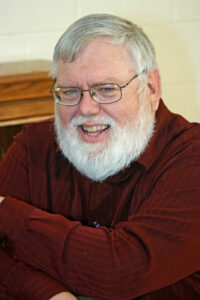“Don’t give me a lot of theological mumbo jumbo,” he said. “I believe in the plain reading of Scripture.” Sounds good to me. Of course we pray for the Holy Spirit to guide us each step of the way. And then we ask of the text, “What did the author say?” Let’s start with Rev. 21: 21, “And the street of the city was pure gold, like transparent glass.”
What in the world is “transparent gold?” Actually, that question demonstrates the problem: transparent gold is out of this world, but it exists in the world made new. To describe what he saw, John uses words he and his audience have in common. We know what gold looks like, and we know what transparent means.
To some degree, we encounter the same challenge with every biblical passage: the prophets who wrote the Bible lived on the same planet we do, but not in the same world, and unless we recognize that we read our world into their words.
An inspired prophet has an experience with God that the rest of us do not. He or she must then communicate that experience, that knowledge, to their contemporary audience, which gives us the second step in good Bible study: “What did his audience understand him to have said?” Any “plain reading” of the Scripture must begin with understanding the world the prophet and his audience lived in.
Today, we are uncommonly blessed in this effort because so many resources are readily available to us. While reading the original languages helps, the Internet gives the rest of us access to interlinear biblical texts, Greek and Hebrew word studies, and many other helpful study aids. Even better, the very composition of most of Scripture makes it available to everyone. As Ellen White said, “The Bible was not written for the scholar alone; on the contrary, it was designed for the common people.”i That’s because the largest portion of scripture consists of stories. Yes, there’s poetry, wisdom literature, letters, prophecy and some theology, but the Bible devotes more space to story than to anything else.
Of course, Jesus himself taught with parables—which is to say, stories. We know this because of the gospels, which are themselves stories. The gospel writers tell us what we need to know by how they tell their stories. Reading John chapters 3 and 4 as story shows how useful this can be.
The third chapter of John contains one of the most familiar stories in the Bible, but understanding it as the audience did reveals fascinating new truths. John tells us that Nicodemus was a ruler of the Jews and that he came by night. Why? Because in the Old Testament, God chose the Jews to be a light to the nations. By telling us Nicodemus came at night John wants us to see the irony of a teacher of the children of light coming to “the Light of the World” — see John 1:4-9 — in darkness.
Jesus tells Nicodemus that he needs to be born again. But in the NASB there’s a footnote that says, “or from above.” ii Jesus is the One ”from above,” as is the new birth He offers, but Nicodemus chose the more literal interpretation. How can we know that? Again, we let John, the storyteller inform us.
After Nicodemus left, still in darkness, John presents a brief testimony from John the Baptist. Part of which says: “He who comes from above is above all; the one who is only from the earth is of the earth and speaks of the earth,” iii neatly summarizing the interchange between Jesus and Nicodemus earlier.
The very next story finds Jesus in Samaria, where a woman comes to the well “about the sixth hour,” or, as the footnote informs us, noon. As far as the Jews were concerned, if Jews were children of the light, the Samaritans must be children of darkness.
With that in mind, a simple survey of the two episodes—Nicodemus and the Woman at the Well—uncovers a wealth of meaning.
Nicodemus came at night, and left still in darkness, not understanding Jesus’ person or mission. The Samaritan woman meets Jesus at noon, and He reveals Himself as the Messiah. The woman returns to her village, not only while it is light, but sharing the light with her neighbors. Nicodemus’ interview could hardly have lasted more than an hour. Jesus stayed with the Samaritans for two whole days!
What does this brief examination teach us? First, by knowing that Jesus actually used a word that could have meant “again,” or “from above,” gives us insight into his discussion with Nicodemus. Second, recognizing how John’s audience would have seen the contrast between night and day, the Jewish teacher and Samaritan woman, provides new depth to our understanding.
In the third step, we apply the truths we have discovered to our own lives, answering the question, “What does this mean for me, today?”
Prov. 27:17 tells us, “As iron sharpens iron, so one person sharpens another.” As a final step, we explain our whole process to others we trust and respect, seeking feedback. Or we can compare our results with published sources.
No easy shortcuts
“Wait a minute,” you may ask, “how does this deal with all the hot topics in the church today?”
To study topics, hot or otherwise, we should follow the same steps, but for multiple passages. Done correctly, this takes a good deal of time and effort. Some passages which appear at first sight to address a topic, may be discussing something completely different. Remember, the biblical authors had a different world view. A common error we all make is to begin with the conclusion we desire, and set about finding passages that appear to support it. This shortcut leads to distortion of the Scripture and deeply flawed conclusions.
God has blessed the church with many scholars and others who explore these topics. No one possesses all truth, so we should read as many as we can, especially where it involves difficult or disputed passages. As we read, we need to examine the process that was followed. Does the author show each of the steps taken? Is the reasoning explained? Does the author seem to be lecturing readers, or exploring the texts with and for them?
Let’s review the steps. After praying for the Spirit’s guidance, seek the answers to these questions:
- What did the author say?
- What did the author intend his audience to understand, and how would they understand it?
- What does that mean for me today? How does it apply to my life?
More than 50 years ago, I had come to find Bible study dull and tedious, so I prayed this prayer: “Please, God, give me a hunger for Your Word.” He answered that prayer, and led me to these steps. I did not invent them, but I endeavor to use them to “Be diligent . . . as a worker who does not need to be ashamed, accurately handling the word of truth.”iv
to these steps. I did not invent them, but I endeavor to use them to “Be diligent . . . as a worker who does not need to be ashamed, accurately handling the word of truth.”iv
In the process I have come to see the Bible as overflowing with treasures too beautiful not to share. I hope you can experience that, too. Some have said to me, “It sounds wonderful, but not easy.” To which I reply, “It’s not easy; it’s joyously difficult!”v
Ed Dickerson is a lay pastor, church planter, writer and speaker. His passion is to do everything in his power to see that, if the Lord tarries, there will be an Adventist church that his children and grandchildren want to belong to.
Notes:
1. Steps to Christ, p. 89.
2. You can verify this for yourself using these websites: https://www.scripture4all.org/OnlineInterlinear/NTpdf/joh3.pdf
https://biblehub.com/greek/509.htm
3. v. 31.
4. 2 Timothy 2:15 NASB
5. Quoting the poet, John Ciardi, who was asked if writing poetry was easy.










